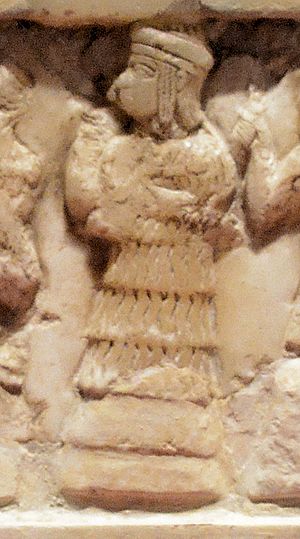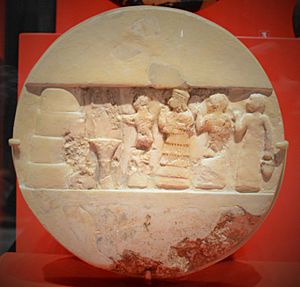Enheduanna facts for kids

Enheduanna was an amazing woman from ancient Sumer. She is the first poet we know by name in all of history! She lived about 4,300 years ago, around 2300 BC.
Enheduanna was a very important person. She was the High Priestess of the goddess Inanna and the moon god Nanna. This means she was a powerful religious leader. She lived in the ancient city of Ur, which was a big city-state in Sumer.
Her writings are very special. She wrote many poems and hymns, which are like songs of praise. These works make her the first author in the world whose name we actually know!
Enheduanna held a very important job called "EN." This role was often given to royal daughters and had a lot of political power. Her father, King Sargon of Akkad, chose her for this position. He did this to help keep control of the southern part of his kingdom, where Ur was located.
She stayed in her role even when her brother, Rimush, became king. At one point, she faced some trouble and was forced to leave her position. But she was later brought back as High Priestess. Her famous poem, 'The Exaltation of Inanna,' tells the story of her struggles and her return to Ur. After she died, people still remembered Enheduanna as a very important figure. Some even thought she was partly divine, like a goddess!
Contents
Discovering Enheduanna's Story

How do we know about Enheduanna? In 1927, a British archaeologist named Sir Leonard Woolley found a special stone disc in the ancient city of Ur. This disc shows Enheduanna and has her name on it. It clearly shows how important she was!
Woolley also found the temple complex where these priestesses were buried. He wrote a short summary about Enheduanna. However, people didn't fully understand how important she was until later. In 1958, Adam Falkenstein wrote the first detailed article about her. Then, in 1968, William Hallo and Van Dijk published the first translations of her works.
Proof from the Past
We know a lot about Enheduanna from both old objects and ancient writings.
- Seals: Two seals with her name were found at the Royal Cemetery in Ur. These seals belonged to her servants and show she was a real person.
- Alabaster Disc: The beautiful alabaster disc with her name and picture was found in the Giparu. This was Enheduanna's main home.
- Copies of Her Work: Many copies of Enheduanna's writings were made hundreds of years after she died. These copies were found in cities like Nippur and Ur. This shows that her works were highly valued, perhaps as much as the writings of kings!
Enheduanna's Amazing Writings
Enheduanna wrote 42 hymns, which are like poems or songs of praise, for temples in different cities across Sumer and Akkad. These include temples in Eridu, Sippar, and Esnunna. We know about these hymns from 37 clay tablets found in Ur and Nippur.
This collection of hymns is called 'The Sumerian Temple Hymns.' Enheduanna was very proud of this work. She wrote: "My king, something has been created that no one has created before." People kept copying these hymns long after she died, showing how important they were.
Her other famous work is 'The Exaltation of Inanna,' also known as 'Nin-Me-Sar-Ra.' This is a very personal poem to the goddess Inanna. It also tells the story of Enheduanna being forced to leave Ur and then returning. Her poems helped connect the Sumerian goddess Inanna with the Akkadian goddess Ishtar.
Enheduanna's ability to write raises an interesting question: How many women could read and write in ancient Mesopotamia? We know that other royal women also wrote or asked for poems to be written. The goddess Nindaba was even seen as a scribe, someone who writes. This shows that women had important roles in ancient society.
You can find most of Enheduanna's works translated online at the Electronic Text Corpus of Sumerian Literature.
Key Compositions
- Nin-me-šara, or "The Exaltation of Inanna": This poem has 153 lines. It starts by praising the goddess Inanna. Then, Enheduanna talks about her sadness at being sent away from the temple and the cities of Ur and Uruk. She asks the moon god Nanna for help.
- In-nin ša-gur-ra: This is another long poem, but it's not complete.
- In-nin me-huš-a, or "Inanna and Ebih": This poem tells a story about Inanna.
- The Temple Hymns: This collection includes 42 hymns of different lengths, each written for a specific temple.
- Hymn to Nanna: A hymn dedicated to the moon god Nanna.
Why Enheduanna Matters Today

For a long time, only experts in ancient history knew about Enheduanna. But in 1976, an American anthropologist named Marta Weigle learned about her. Weigle then shared Enheduanna's story with people studying women's history. Weigle called her "the first known author in world (written) literature."
Since then, Enheduanna has become very important in feminism, which is about equal rights for women. People celebrate her as not only the earliest known poet but also one of the first women known by name in history.
- In 2014, for International Women's Day, a special event in Iraq talked about Enheduanna. They called her a major female Sumerian poet.
- In 2017, Professor Eleanor Robson described Enheduanna as "a wish-fulfillment figure." This means she represents an inspiring image of what women can achieve.
Enheduanna is even seen as an early thinker about how people use language to persuade others. Scholars like Roberta Binkley say that Enheduanna used clever ways to write her poems. She used emotions, ethics, and logic in her poem "The Exaltation of Inanna." These writing techniques were used almost 2,000 years before the famous Greek thinkers! Binkley suggests that Enheduanna's work isn't as well-known because of her gender and where she lived.
Enheduanna was also featured in the science TV show Cosmos: A Spacetime Odyssey in an episode called "The Immortals." She was even voiced by famous journalist Christiane Amanpour!
In 2015, the International Astronomical Union named a crater on the planet Mercury after Enheduanna. This shows her lasting impact on history and beyond!
Images for kids
-
Enheduanna's father, Sargon of Akkad, started the Akkadian Empire in the 24th century BCE.
-
Scribes in the First Babylonian Empire would have copied Sumerian writings like The Exaltation of Inanna as part of their training.
-
A Sumerian clay tablet with the poem Inanna and Ebih written on it.
See also
 In Spanish: Enheduanna para niños
In Spanish: Enheduanna para niños





